
Culture & Community | Politics | Arts & Culture
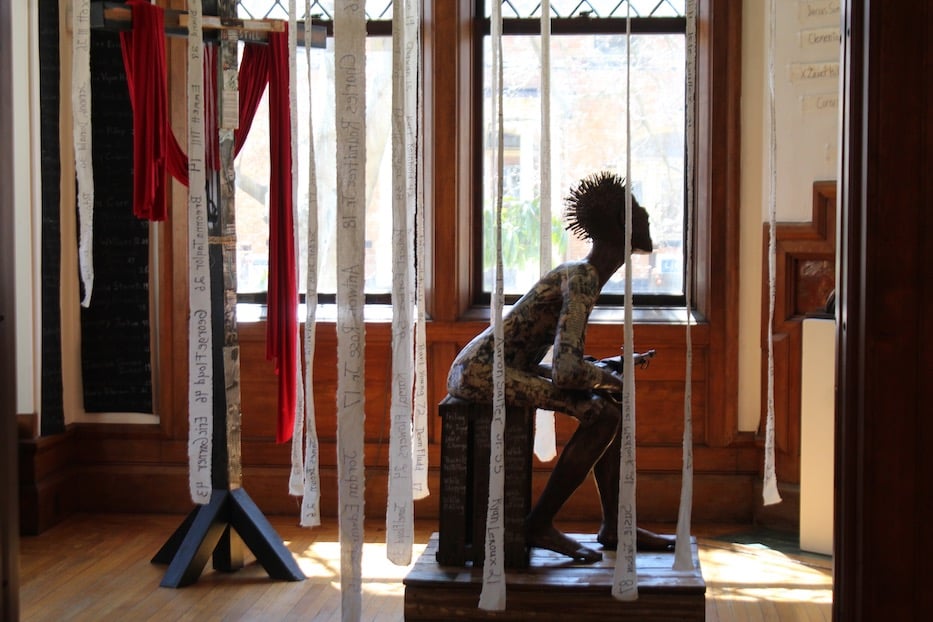
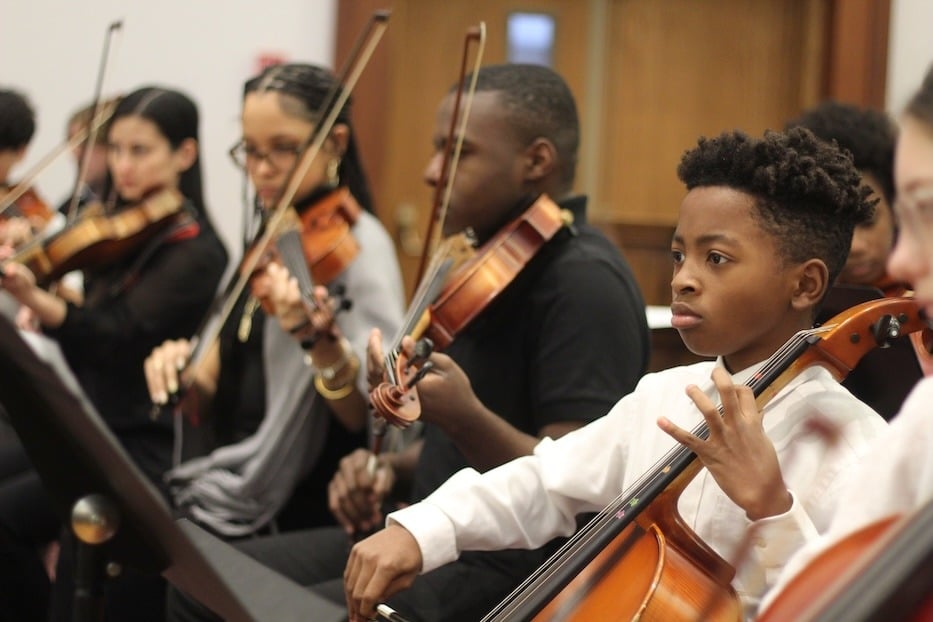
Top: Linda Vauters Mickens’ “Redemption” installed at the Ely Center of Contemporary Art (ECoCA) at 51 Trumbull St. in March 2023. Bottom: Amiel "AJ" Johnson, a sixth grader at Nathan Hale School, plays in Music Haven's 2025 Martin Luther King, Jr. Day concert. Lucy Gellman Photos.
When Milda Torres McClain first heard that the Trump Administration would be freezing federal funding, she was speechless. Then she started thinking about the students she serves at Music Haven every day.
Those students attend public schools. They get to Music Haven on a bus provided by the district. Many of them rely on public transportation, benefit from free school lunch, are part of programs like Medicaid and CHIP. Their music lessons remain free, in part, because of an education grant from the National Endowment for the Arts (NEA). It all felt like a nightmare.
Tuesday, McClain was one of dozens of Connecticut arts administrators—and hundreds of individual artists—scrambling to figure out what a freeze on federal funding might mean for them after the Office of Management and Budget (OMB) released a memo pausing federal grants and loans Monday night. In a day filled with chaos and confusion, many found themselves reassessing programming, talking unexpectedly to students and staff, and asking what the future of their work will look like under the Trump Administration.
Even in the arts—a sector that receives relatively few federal dollars—it brought home how deeply federal funding is woven into every aspect of daily life, including the public goods and services on which many artists rely to survive. Even after a judge temporarily blocked the freeze Tuesday afternoon, a sense of uncertainty remained among those in the field, who no longer know what to expect from Washington.
As of Tuesday evening, a judge in Washington, D.C. put a pause on the memo. At the same time, White House Press Secretary Karoline Leavitt tweeted that the freeze was still in effect, sowing further disquiet among town and city governments and social service providers across the country. Then on Wednesday, the Trump Administration reversed the freeze, but said that a move to review and end “woke” ideologies would continue.

“I'm just speechless,” said McClain, whose organization’s $1 million general operating budget includes $25,000 in funding from the National Endowment for the Arts, in a phone call Tuesday evening. “It allows us to reach so many students and to prepare them to be the next generation of artists and leaders. At nonprofits, we have to penny pinch—we provide one-on-one music lessons, group lessons, snacks, tutoring, music help, and culturally sensitive workshops.”
“We want students to come here every day of the week … we want them to know that this is a safe place for them,” she added. “We do individualized programming depending on the needs of the students. We rely on the Board of Education for transportation. If that funding is cut, our students suffer.”
Tuesday, that story repeated over and over again in greater New Haven and across the state (and in Washington, where legislators like U.S. Sen. Chris Murphy called it an attempt “to undermine the very premise of American democracy.”) As city and state officials outlined a potentially devastating blow to basic services, arts leaders tried to figure out exactly what would be affected, and how quickly.
In Hartford, state Director of Arts, Preservation and Museums Elizabeth Shapiro called it “too early to know what this means,” but acknowledged that the Connecticut Office of the Arts (CoA) would almost certainly be affected (as would the State Historic Preservation Office or SHPO, which she also leads) in the next fiscal year. CoA's grant programs for this fiscal year appear unscathed, she said.
Currently, CoA receives $1,497,298 in discretionary spending from the State of Connecticut, as well as roughly $850,000 in interest from the Connecticut Arts Endowment. The other $1,026,100—roughly half of the office’s budget—comes from the National Endowment for the Arts. That money goes to statewide grants and covers one staff salary; two additional program associates are currently funded by the American Rescue Plan Act (ARPA), which must be used by the end of 2026.
“There are a lot of unknowns right now,” she said. She added that she’s in frequent contact with the National Association of State Arts Agencies (NASAA), which is still working to figure out what the next weeks—let alone the next four years—look like in terms of arts funding. Asked for a comment, a NASAA spokesperson said that the association is still monitoring the situation.
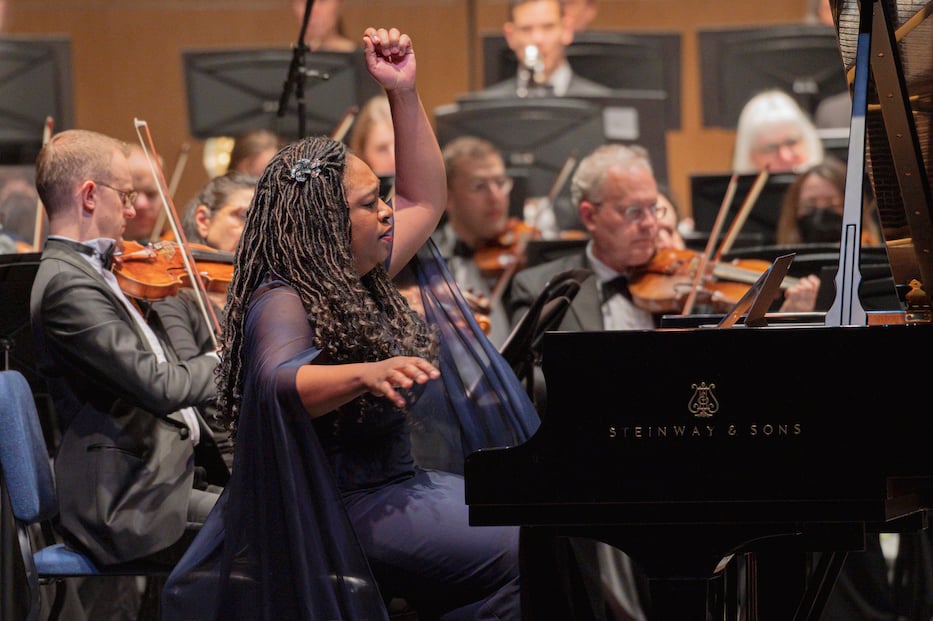
Pianist Michelle Cann plays with the NHSO in spring 2023. Matt Fried Photos courtesy of the New Haven Symphony Orchestra.
Arts leaders in and beyond New Haven echoed that uncertain feeling Tuesday, pointing to the far-reaching impact that a freeze could have on every aspect of daily life. Artists and creatives, many noted, also happen to be humans: they send their kids to public schools, ride the city bus, cycle, walk and drive on public infrastructure, use early childhood education programs like Head Start. They sometimes need access to subsidized housing, refugee resettlement programs, and social services like SNAP (Supplemental Nutrition Assistance) and WIC (Women, Infants and Children).
They include dreamers, immigrants, and refugees, LGBTQ+ people, and trans and nonbinary kids who need access to gender-affirming care. In other words, they are already vulnerable to the attacks of a nascent administration, and now risk losing their livelihoods in the midst of it.
Elaine Carroll, who leads the New Haven Symphony Orchestra, pointed to the role that NEA funding plays in paying artists and doing new and responsive programming, particularly as the NHSO grows its repertoire and artistic footprint. In the past several years, federal dollars have covered the Helen Hagan Project, Harmony Fellowships, a Harlem Renaissance concert and Covid-19 job creation program that give artists work and teach audiences about new music in the process. Since 2019, it has received between $15,000 and $20,000 per year for its programming.
“What we use this grant to do almost exclusively is to pay musicians' salaries,” Carroll said. Artists, in turn, “use that money to pay rent, to buy groceries,” and to fulfill other basic needs. If it’s cut off, that means fewer opportunities to pay artists who are trying—often through multiple gigs, teaching, and side hustles—to simply pay their bills.
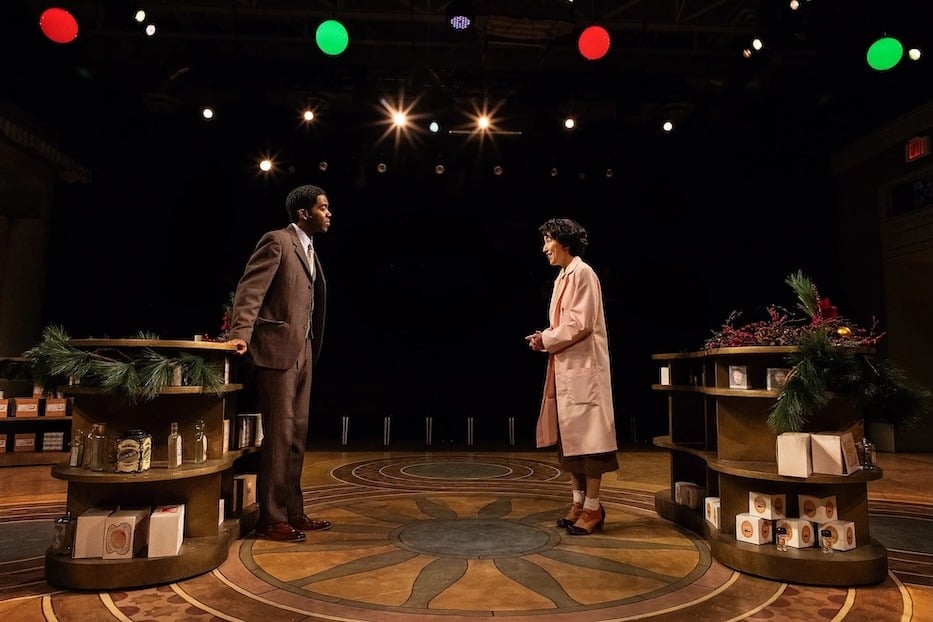
Long Wharf's She Loves Me in December 2024. Curtis Brown Photo.
That was the story at several nonprofits across the city. Eric Gershman, interim managing director at Long Wharf Theatre, noted the potential gap in programming that a freeze on NEA funds could cause the theater, which is currently in its second season in itinerancy. As tech rehearsals for El Coquí Espectacular and the Bottle of Doom continued at Southern Connecticut State University, Gershman explained that $110,000 of the theater’s current $4.3 million budget comes from the NEA. Of that, Long Wharf has only received $7,500 thus far. In addition, the theater has a $75,000 NEA grant that it plans to use in the next fiscal year.
“Long Wharf Theatre’s NEA-funded projects support some of our most important community engagement initiatives,” he said in a statement Tuesday afternoon. “Should all federal arts funding stop, we may be forced to cancel or postpone these projects, which would prevent us from engaging and paying several artists and collaborators who rely on this work.”
“This would not only impact our sustainability as an organization and the livelihood of our artists and collaborators, but it would also negatively impact New Haven’s economy as the retail, hospitality, restaurant, and transportation sectors would also suffer from lower levels of activity.”
Tuesday afternoon, several individual artists said that they also feel anxious about what the freeze on federal funding means for them, both in and well beyond the realm of arts and culture. While artists don’t receive direct grants from agencies like the NEA, they often benefit from the regranting of those funds, whether through a Designated Regional Services Organization (DRSO) or a 501c3 nonprofit that has gotten funds for specific programming.
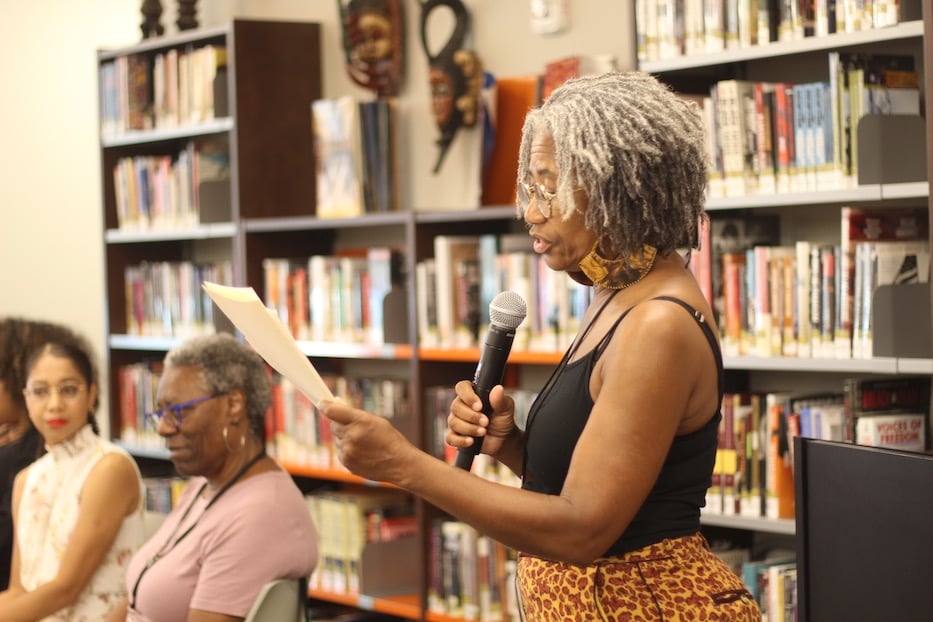
Gardin at Kulturally LIT Fest in 2023.
Reached by phone, sculptor Linda Mickens called it “such an assault” on the rights and protections of artists—and of all Americans—who are just trying to live. In 2023, Mickens was a member of the New Haven Artists Corps, which has received funding from the NEA as well as the Mellon Foundation. Her work, which often looks unflinchingly at Black history, pushes back against what she sees as an attempt to censor and silence those who speak out against injustice.
In the interest of full disclosure, the Artists Corps is administered through the Arts Council of Greater New Haven, with which the Arts Paper is affiliated but editorially independent from.
“The aim is to quiet you, to not allow you to talk, to speak, to express yourself,” she said in a phone call Tuesday evening. “The arts have been hated in hard times, not just here, but all over the planet. You look at artists living the hard life —economically, racially—and then you take away grants that would help them. For me, it’s like, I’m really trying to hold on. He’s been in office not even a month and he’s wiping things away.”
“It is painful,” she continued with a catch in her throat. “It's devastating, it’s very concerning, and it’s depressing. People say we still have to have joy, and I understand that, but it's so much. It's just painful. And sometimes I feel like it's just hopeless as hell.”
Kulturally LIT founder IfeMichelle Gardin, who has served as an Artist Corps mentor and worked for several organizations that have received NEA funding, added that she’s bracing for a lack of federal help in arts and culture—but still trying to hold onto hope and harness creativity to organize.
Last year, she incorporated Kulturally LIT as a 501c3 organization specifically so she could qualify for grants, including those from the NEA (and NEA funds redistributed by state and city offices). Now, she’s trying to move forward without any expectations that those dollars will come in.
“I still believe in our mission in this era of banned books,” she said in a phone call Tuesday. “We’re still gonna be out here doing stuff and be more intentional about collaborating with people—hoping that folks believe in this because we have to come together. Our country has lived through oppression, depression, multiple wars, segregation—all the things that they [members of the Trump Administration] think America was great for.
She looked to the spirit—and the youth leadership—of collective organizing, including in the Student Nonviolent Coordinating Committee (SNCC) and the Black Panther Party. “That is my prayer,” she said. “That people start collectively coming together.”

